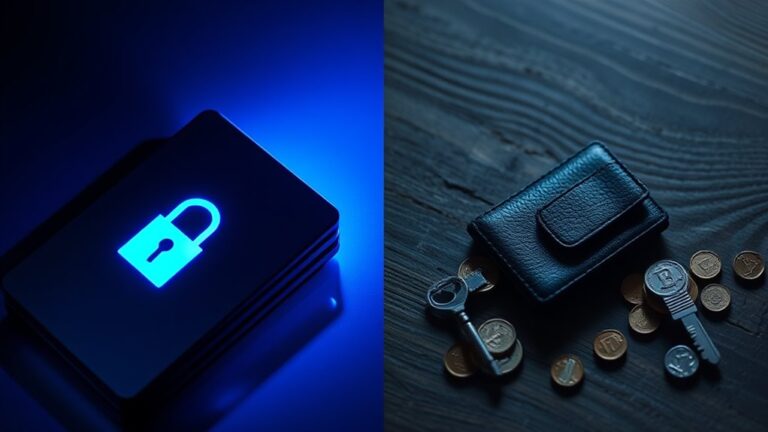
Types of Crypto Wallets: What’s Best for You?
There are several types of crypto wallets, each with unique features tailored to user needs. Software wallets include mobile and desktop options, providing convenience and accessibility. Hardware wallets guarantee high security by storing keys offline, while custodial wallets manage keys through third-party services. Non-custodial wallets offer users full control over their assets. Choosing the right wallet depends on factors like security, ease of use, and transaction flexibility. Understanding these aspects can lead to informed decisions about wallet selection.
Key Takeaways
- Assess Security Needs: Choose between custodial wallets for convenience or non-custodial wallets for enhanced security and control over your assets.
- Consider Usage: For frequent transactions, mobile wallets offer portability, while desktop wallets provide more security for larger holdings.
- Evaluate Support for Cryptocurrencies: Ensure the wallet supports the specific cryptocurrencies you plan to use or invest in.
- Check User Interface: Select a wallet with an intuitive interface that suits your experience level and makes navigation easy.
- Review Fees and Costs: Be aware of any transaction fees, withdrawal costs, or maintenance charges associated with the wallet options you consider.
Understanding Crypto Wallets

Understanding crypto wallets is essential for anyone looking to engage with digital currencies, as these tools are fundamental to managing, storing, and transacting cryptocurrencies.
Crypto wallets are primarily categorized into software, hardware, and paper wallets, each serving different purposes. These wallets can be further divided into hot wallets, which are internet-connected and convenient for frequent transactions, and cold wallets, which store assets offline, providing higher security.
Additionally, wallets are classified as custodial or non-custodial, impacting ownership and control of private keys. Each type offers unique features and advantages, making it important for users to assess their security needs and transaction frequency when selecting a wallet. Mobile wallets are particularly useful for in-store purchases, while desktop wallets are more suitable for online payments.
Understanding these distinctions is vital for effective cryptocurrency management.
Exploring Software Wallets

Software wallets play an essential role in the management and transactions of cryptocurrencies, catering to various user needs and preferences. They can be categorized into several types, each with distinct features.
| Type | Description | Key Features |
|---|---|---|
| Mobile Wallets | Portable for on-the-go transactions | User-friendly, multi-currency support |
| Desktop Wallets | Enhanced security on specific devices | Encryption, secure key storage |
| Web Wallets | Accessible through web browsers | Easy access, no local installation |
| Browser Extension | Integrates with decentralized applications | Compatibility with dApps |
| Hybrid Wallets | Combines software and hardware elements | Extra security measures |
These wallets offer convenience, usability, and varying levels of security, making them suitable options for different users. Additionally, software wallets are often referred to as “hot wallets” due to their connection to the internet, which enhances convenience but also exposes users to online security risks such as hacking and malware.
The Advantages of Hardware Wallets

Hardware wallets offer a robust alternative for cryptocurrency storage, prioritizing security and user control.
These devices, such as the Trezor Safe 5 and Ledger Flex, utilize secure elements akin to those found in passports, enhancing protection against tampering. They store keys offline, making them immune to hackers and malware, and often incorporate the Elliptic Curve Digital Signature Algorithm for strong cryptographic security.
Users benefit from intuitive interfaces and companion apps that facilitate transactions without exposing keys. Furthermore, hardware wallets support multiple cryptocurrencies and receive regular firmware updates to maintain security. Additionally, using hardware wallets for secure storage ensures that users maintain control over their assets, protecting them from unauthorized access.
Paper Wallets: A Traditional Approach

Paper wallets represent a traditional method of storing cryptocurrency by providing a physical document that contains essential cryptographic keys.
Their offline nature enhances security, making them less vulnerable to online threats, but users must consider careful creation and usage practices to maintain their integrity.
Additionally, proper storage and preservation are vital to protect these wallets from physical damage, ensuring long-term access to the stored funds.
Creation and Usage
Generating a paper wallet involves a methodical approach to guarantee the security of cryptocurrency assets. A paper wallet is defined as a physical piece of paper containing both public and private keys.
The creation process typically occurs offline, using trusted software like BitAddress, which helps prevent digital exposure. Once generated, the keys are printed or written on paper, often with QR codes for ease of use.
Paper wallets are commonly utilized for long-term storage of significant cryptocurrency amounts, as well as for gifting smaller amounts. Additionally, they serve as educational tools, aiding in the understanding of blockchain technology. However, users should also consider implementing strong security practices, such as using trusted exchanges, to further safeguard their digital assets.
Despite their benefits, users should consider the physical risks associated with paper wallets, including theft or damage.
Security Considerations
When considering the security of cryptocurrency storage methods, paper wallets offer a unique blend of advantages and risks. Their offline nature protects against online hacking, making them immune to digital threats.
However, paper wallets are vulnerable to physical theft, damage, and loss, as they can easily degrade or be misplaced. To enhance security, it is essential to use reputable generators when creating paper wallets, as fraudulent software can compromise keys.
Additionally, devices used for generation should be scanned for malware to prevent infections. While providing full control over funds, the potential for human error during recording or storage poses significant risks, and losing a paper wallet often results in irreversible access loss. Maintaining secure backups of private keys is crucial to ensuring you don’t lose access to your assets.
Storage and Preservation
In the domain of cryptocurrency storage, paper wallets represent a traditional approach that appeals to many users seeking a secure, offline method for holding their assets.
These wallets store both private and public keys on a piece of paper, allowing for a cost-effective storage solution that requires only a printer. By generating keys offline, paper wallets protect against digital threats, making them a form of cold storage.
However, their physical nature makes them vulnerable to damage from water or fire. Additionally, users must securely store the paper to prevent loss.
While paper wallets are ideal for long-term holding, they can complicate access to funds for frequent transactions, requiring users to import private keys into digital wallets for usage. Furthermore, many cryptocurrency enthusiasts choose a combination of hot and cold wallets to balance convenience and security.
Custodial Wallets Explained

Custodial wallets serve as a practical option for individuals who wish to engage with cryptocurrency without the complexities of managing their own private keys. These wallets are typically provided by centralized exchanges and offer a user-friendly experience.
Key characteristics include:
- A third party holds users’ private keys and manages transactions.
- Web-based interfaces make them accessible for newcomers.
- Backup options are available to recover lost accounts or passwords.
- Integration with decentralized apps enhances functionality.
While custodial wallets simplify the process for users, they require trust in the provider’s security measures. Additionally, custodial wallets are more vulnerable to hacks and security breaches due to the reliance on a third party to manage assets.
Users do not directly control their assets, which can raise concerns about ownership and security. It is essential to evaluate the reputation of custodial services before use.
The Benefits of Non-Custodial Wallets

Non-custodial wallets offer users full control over their assets by allowing them to manage their private keys independently.
This independence enhances security features, as users are less vulnerable to data breaches and centralized hacks.
Additionally, the direct access to blockchain transactions enables faster and more flexible management of cryptocurrency assets without third-party interference. Furthermore, these wallets facilitate seamless interaction with decentralized applications (dApps), empowering users to engage in various DeFi activities like lending and yield farming.
Full Control Over Assets
A significant advantage of non-custodial wallets is the full control they provide over digital assets. Users manage their own private keys, which contrasts with custodial wallets where a third party controls them.
This autonomy comes with several benefits:
- Transaction Flexibility: Users can conduct instant withdrawals and transactions without needing approval from intermediaries.
- Censorship Resistance: Complete access to assets protects against external interference.
- Decentralized Philosophy: Non-custodial wallets align with the core principles of blockchain by empowering users directly.
- Liability and Responsibility: Users are accountable for securing their private keys, reinforcing their control.
This structure fosters a sense of ownership and privacy, allowing individuals to navigate the digital asset landscape with greater independence. Additionally, non-custodial wallets can be enhanced with features like multisig wallets, which require multiple signatures for added security.
Enhanced Security Features
In the domain of cryptocurrency, enhanced security features play an essential role in safeguarding digital assets. Non-custodial wallets prioritize security through multi-layer systems, including two-factor and biometric authentication, along with encryption protocols.
These wallets enable offline transactions, particularly with hardware options, markedly reducing hacking risks. Users maintain control over their private keys, ensuring that only they can access their funds.
Robust backup options, such as seed phrases, provide recovery solutions in case of device loss. Additionally, advanced encryption algorithms protect data and transactions. A crypto wallet functions by storing private and public keys, which is crucial for facilitating secure transactions on the blockchain.
This multi-faceted approach to security empowers users to manage their assets with greater confidence, making non-custodial wallets a preferred choice for those valuing security in the cryptocurrency space.
Key Factors in Choosing Your Wallet

How does one determine the best crypto wallet to meet their needs? Several key factors influence this decision, guiding users toward a suitable choice.
First, they should consider the type of wallet, such as custodial versus non-custodial options.
Considering the wallet type—custodial or non-custodial—is crucial in finding the right fit for your crypto needs.
Additionally, evaluating wallet features is essential, including:
- Asset Support: The variety of cryptocurrencies a wallet can hold.
- User Interface: The ease of navigation and overall user experience.
- Fees and Costs: Any transaction or maintenance fees associated with the wallet.
- Recovery Options: Features that assist in recovering access to lost assets.
Balancing Security and Convenience

Balancing security and convenience represents a critical challenge for cryptocurrency users seeking to protect their assets while maintaining easy access.
Hardware wallets excel in security by storing private keys offline, thereby minimizing exposure to hacking. They utilize encryption and multifactor authentication to safeguard funds. However, these wallets are not immune to physical risks such as theft or damage.
On the other hand, custodial wallets offer greater convenience but at the cost of user control. The trade-offs often involve additional security measures like two-factor authentication, which can complicate access.
Users may adopt hybrid approaches, employing software wallets for daily transactions and hardware wallets for long-term storage, effectively managing the balance between security and ease of use.
Frequently Asked Questions
Can I Switch Between Custodial and Non-Custodial Wallets Easily?
Switching between custodial and non-custodial wallets can be done, but requires careful attention. Users must manage transfers, ensuring compatibility, and remain vigilant against security risks to protect their assets during the process.
What Happens if I Lose My Hardware Wallet?
Losing a hardware wallet can feel like losing a treasure chest. However, if the recovery seed phrase is securely backed up, assets can still be recovered using compatible wallets, emphasizing the importance of diligent safeguards.
Are There Fees Associated With Using Different Wallet Types?
Fees associated with different wallet types can vary considerably. Custodial wallets often have minimal usage fees but lack asset control, while non-custodial wallets typically incur transaction fees, linked to network conditions and optional services.
How Often Should I Update My Software Wallet?
The frequency of updating a software wallet should ideally be monthly. Regular updates guarantee security, enhance functionality, and maintain compatibility with evolving blockchain networks, thereby protecting users against emerging vulnerabilities and threats effectively.
Can I Use a Paper Wallet for Multiple Cryptocurrencies?
Ah, the dream of a multi-talented paper wallet! Unfortunately, it can only juggle one cryptocurrency at a time, making it a rather clumsy choice for those seeking efficiency and convenience in their digital asset management.
Conclusion
To sum up, selecting the right crypto wallet requires careful consideration of individual needs and preferences. Each type of wallet—software, hardware, paper, custodial, and non-custodial—offers distinct advantages and trade-offs. Just as a knight chooses their armor based on the battle ahead, users must balance security and convenience to protect their digital assets. By understanding the features and risks associated with each option, individuals can make informed choices that align with their cryptocurrency goals.












